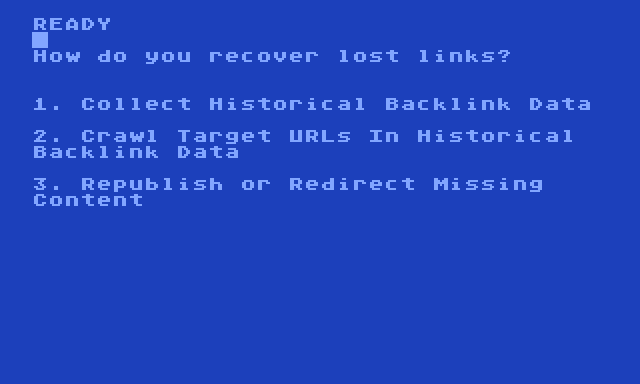Getting links to point to your website can be an extremely difficult task. That’s why before you start the hard work of getting NEW links you should first make sure that you are currently getting the most out all of the existing links pointing to your website.
One of the most overlooked aspects of link building is ensuring that all of your existing links pointing to your website are passing value on to the rest of the site.
In many cases especially for large older websites there may be pages that have attracted links in the past which do not exist any longer. For example 4 or 5 years ago you may have published a very popular blog post that acquired a handful of links from other publications.
However, since then you’ve deleted that blog post or it’s been accidentally taken down. Because of this, the URL that the blog post used to be at likely sends a 404 response code when accessed. When search engines crawl this URL they are likely discounting or ignoring any links pointing to that URL because it is sending a 404 signal.
To ensure that all of your current links are pointing at pages that do not send 404 signals you should follow these steps to make sure you’re getting the full benefit of your existing back link profile.
1. Collect Historical Backlink Data
To get started with this strategy you’ll need to collect the historical backlinks for your site. This means you want to collect all of the backlinks that have been created that point at your site over the entire lifespan of the website. Many backlink providers will only show you existing backlinks providing value for SEO. However a historical backlink analysis will show you all of the links whether they are still providing value or not.
Each backlink data provider will provide this set of backlinks in different ways. Majestic.com for example, call it a “historical index” and in other providers provide it by default. Either way you want to make sure that you are looking at a complete data set of all the links that have been built for the entire lifespan of the website. In some cases it may be beneficial to combine multiple data sources to get the most complete picture.
2. Crawl Target URLs In Historical Backlink Data
After you have collected your complete backlink profile you will now need to identify which pages on the site no longer exist and are still receiving backlinks. To do this you should copy the list of Target URLs within the data set that are receiving backlinks.
These are simply pages on your website that are receiving backlinks within the data set. After you have collected this list of pages use a crawling tool such as screamingfrog psych ball or sleuth to crawl the list of urls.
After you have collected your complete backlink profile you will now need to identify which pages on the site no longer exist and are still receiving backlinks. To do this you should copy the list of Target URLs within the data set that are receiving backlinks.
These are simply pages on your website that are receiving backlinks within the data set. After you have collected this list of pages use a crawling tool such as ScreamingFrog, Sitebulb, or Xenu’s Link Sleuth to crawl this list of URLs.
After the crawl is completed segment which URLs send a 404 response and extract this list. These are the pagers that are currently receiving backlinks from other websites that no longer exist on your site. You can use this list to compare against your original backlink data set to identify the number of links each of these pages are currently receiving.
This can be a helpful way to prioritize your efforts in the next step.
3. Republish or Redirect Missing Content
Using this list of 404 errors that you collected in the previous step, you can then decide which pages should be republished or redirected. If a page is able to be re-published, that is most likely the best choice because it will provide immediate benefit for SEO.
However if the content is not able to be re-published you should redirect the URL to a related piece of content on the site. You can prioritize which URLs to focus on first based on the number of links pointing at them found in your original data set.
Even though this strategy does not focus on building new backlinks to the site, it can provide an almost immediate boost because you are recapturing link equity formerly lost.
Performing this same strategy at least once a year can help ensure that you are getting the most value out of all of the links pointing towards the domain.
Don’t want to do the link building work all by yourself?
